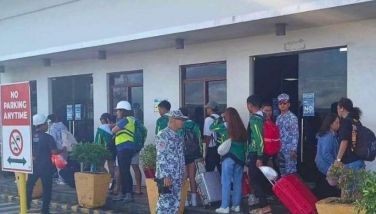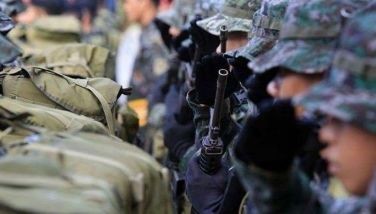Government reviewing plans to counter communist insurgency
April 2, 2005 | 12:00am
Cash-strapped and beset by multiple internal security threats, the Philippines is reviewing its plans to counter a resurgence of a decades-old Maoist rebellion, officials said Friday.
The threat posed by the New People’s Army (NPA) had made it imperative for President Gloria Arroyo to try to strike a swift political settlement with Muslim guerrillas operating in the southern third of the country, Defense Secretary Avelino Cruz said.
A peace deal from talks with the 12,000-member Moro Islamic Liberation Front (MILF), scheduled to start in Malaysia in two weeks, would free up troops and resources to wrest the initiative from the 8,000-member NPA, Cruz said.
"The greatest internal security threat to the country now is the CPP-NPA," he told a Foreign Correspondents Association press briefing here.
"If you are able to solve the CPP-NPA threat that will mean a dramatic increase in your economic growth," due to improved agricultural productivity and opening up of insurgency-influenced areas to tourism and foreign investment.
The revised strategy should allow the armed forces to bring the 36-year rebellion under control within six to 10 years, he added.
"There is a review now headed by (armed forces chief of staff) General Efren Abu," Cruz said.
The objective was to "update and fine-tune the campaign plan" against the NPA and its mother organization the Communist Party of the Philippines (CPP).
Security officials estimate about P90 billion would be needed in the next 12 years to buy military equipment, fund the construction of civilian infrastructure and create jobs in areas influenced by the insurgency.
"We need mobility — trucks, transport helicopters and transport ships — given the widely dispersed nature of insurgent forces," Armed Forces vice chief of staff Rear Adm. Ariston de los Reyes told the briefing.
The two officials traced the roots of the revived communist threat to the withdrawal of US military aid to its former colony and current defense ally when Manila refused to extend the lease on two major military bases in the Philippines after 1992.
They also cited as an ill-advised law that shifted the primary counter-insurgency task from the military to police.
They said the recovery of the NPA, whose armed ranks swelled to 12,000 in 2000 from a low of about 5,000 in 1995, effectively torpedoed a 15-year, P350-billion military modernization law passed in 1995.
The defense department was forced to reallocate funds to meeting the increased internal security threat from the NPA as well as the MILF and the Abu Sayyaf, an al-Qaeda-linked group of Islamic militants waging a kidnapping and bombing campaign.
De los Reyes said the armed forces would only be able to start retooling to meet external security threats by 2017, when he said Manila would need about P20 billion a year over six years for new aircraft and navy vessels.
NPA ranks are down to about 8,000, "but we should not be satisfied with the decline" because of the drag it posed on the economy, Cruz said.
"From a strategic point of view, it is important to reach a peace agreement with the MILF," he added.
This would free up "two and a half divisions" of the Army, now deployed in the Muslim south, so they could "concentrate on other security threats in the country."
Cruz said the government had set aside P2.5-P5.0 billion a year from 2005 to build roads, schools and medical facilities, as well as livelihood opportunities in 500 "showcase villages" throughout the country.
"We are offering them an alternative way of life to the one using armed resistance to the government," he said. "If it works we will continue doing this on a new set of 500 villages" every year. — AFP
The threat posed by the New People’s Army (NPA) had made it imperative for President Gloria Arroyo to try to strike a swift political settlement with Muslim guerrillas operating in the southern third of the country, Defense Secretary Avelino Cruz said.
A peace deal from talks with the 12,000-member Moro Islamic Liberation Front (MILF), scheduled to start in Malaysia in two weeks, would free up troops and resources to wrest the initiative from the 8,000-member NPA, Cruz said.
"The greatest internal security threat to the country now is the CPP-NPA," he told a Foreign Correspondents Association press briefing here.
"If you are able to solve the CPP-NPA threat that will mean a dramatic increase in your economic growth," due to improved agricultural productivity and opening up of insurgency-influenced areas to tourism and foreign investment.
The revised strategy should allow the armed forces to bring the 36-year rebellion under control within six to 10 years, he added.
"There is a review now headed by (armed forces chief of staff) General Efren Abu," Cruz said.
The objective was to "update and fine-tune the campaign plan" against the NPA and its mother organization the Communist Party of the Philippines (CPP).
Security officials estimate about P90 billion would be needed in the next 12 years to buy military equipment, fund the construction of civilian infrastructure and create jobs in areas influenced by the insurgency.
"We need mobility — trucks, transport helicopters and transport ships — given the widely dispersed nature of insurgent forces," Armed Forces vice chief of staff Rear Adm. Ariston de los Reyes told the briefing.
The two officials traced the roots of the revived communist threat to the withdrawal of US military aid to its former colony and current defense ally when Manila refused to extend the lease on two major military bases in the Philippines after 1992.
They also cited as an ill-advised law that shifted the primary counter-insurgency task from the military to police.
They said the recovery of the NPA, whose armed ranks swelled to 12,000 in 2000 from a low of about 5,000 in 1995, effectively torpedoed a 15-year, P350-billion military modernization law passed in 1995.
The defense department was forced to reallocate funds to meeting the increased internal security threat from the NPA as well as the MILF and the Abu Sayyaf, an al-Qaeda-linked group of Islamic militants waging a kidnapping and bombing campaign.
De los Reyes said the armed forces would only be able to start retooling to meet external security threats by 2017, when he said Manila would need about P20 billion a year over six years for new aircraft and navy vessels.
NPA ranks are down to about 8,000, "but we should not be satisfied with the decline" because of the drag it posed on the economy, Cruz said.
"From a strategic point of view, it is important to reach a peace agreement with the MILF," he added.
This would free up "two and a half divisions" of the Army, now deployed in the Muslim south, so they could "concentrate on other security threats in the country."
Cruz said the government had set aside P2.5-P5.0 billion a year from 2005 to build roads, schools and medical facilities, as well as livelihood opportunities in 500 "showcase villages" throughout the country.
"We are offering them an alternative way of life to the one using armed resistance to the government," he said. "If it works we will continue doing this on a new set of 500 villages" every year. — AFP
BrandSpace Articles
<
>
- Latest
- Trending
Trending
Latest






























